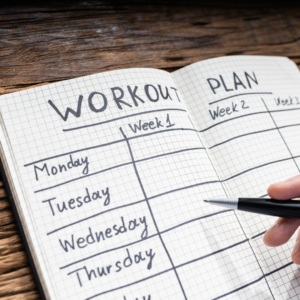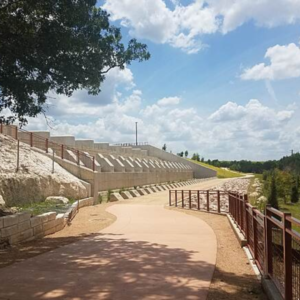Hey there, future half marathoners! Blaze here, your trusty guide and the fiery mascot of the Austin International Half. August is here, and it’s the perfect time to start gearing up for the big race. Whether you’re a seasoned runner or just lacing up your sneakers for the first time, I’ve got five essential tips to help you kickstart your journey to the Austin International Half. Let’s blaze a trail to success together!
1. Set Clear Goals and Make a Plan
First things first, set clear, achievable goals. Do you want to finish the race, hit a specific time, or just enjoy the journey? Whatever your aim, having a goal will keep you motivated. Once you’ve set your sights, create a training plan that suits your level. Learn how to set your training goals.
Beginners might start with a run/walk program, while experienced runners can focus on improving their pace and endurance. Consistency is key, so stick to your plan and watch those miles add up!
2. Explore Austin’s Scenic Running Spots
One of the best parts about training for the Austin International Half is exploring the city’s fantastic running routes. From Town Lake Trail to the challenging hills of Barton Creek Greenbelt, Austin offers a variety of terrains to keep your runs interesting. Not only will you build stamina, but you’ll also fall in love with the vibrant running community and the beautiful Texas scenery.
Grab a friend and hit the trails! Looking for more running friends? Consider joining a group run, find full listing at werunaustin.com

3. Fuel Your Body Right
Running a half marathon is as much about nutrition as it is about training. Fueling your body with the right foods will boost your energy and improve recovery. Focus on a balanced diet rich in lean proteins, whole grains, fruits, and vegetables.
Don’t forget to stay hydrated, especially in the Texas heat. Experiment with different pre-run and post-run snacks to see what works best for you. Remember, you are what you eat, so nourish your body for peak performance.

4. Incorporate Cross-Training and Rest Days
Variety is the spice of life, and the same goes for your training routine. Incorporate cross-training activities like cycling, swimming, or strength training to build overall fitness and prevent injury. These activities work different muscle groups and keep your workouts exciting. Equally important are rest days.
Your body needs time to recover and build strength, so don’t skip them. Listen to your body – it’s the best coach you have.

5. Stay Positive and Have Fun
Lastly, keep a positive mindset and enjoy the journey. Training for a half marathon is a big commitment, and it’s normal to have ups and downs. Celebrate your progress, no matter how small, and don’t be too hard on yourself.
Surround yourself with supportive friends, join running groups, and share your experiences. The Austin International Half is all about community and having a blast, so make sure to have fun along the way!
There you have it, folks – Blaze’s top five tips to kickstart your half marathon journey. Remember, every step you take brings you closer to that finish line. Stay motivated, stay positive, and let’s make this journey to the Austin International Half unforgettable. See you on the trails!
Flaming with enthusiasm, Blaze
Congratulations on finishing your run through Austin’s vibrant streets! Now, it’s time to kick back and relax. Here are some top local spots in Austin where you can unwind, refuel, and soak in the city’s unique vibe after your run.
1. Barton Springs Pool
Nothing beats a refreshing dip in Barton Springs Pool after a long run. This natural spring-fed pool maintains a cool temperature year-round, perfect for soothing those tired muscles. Spread out on the grassy hill and let the cool waters wash away the exertion of your run.
2. Juiceland
Replenish your energy with a nutritious smoothie from Juiceland. With several locations around Austin, including one near Zilker Park, it’s a convenient stop for fresh juices, smoothies, and healthy snacks. Their vibrant, plant-based offerings will help you refuel and rehydrate naturally.
3. The Austin Beer Garden Brewing Co. (ABGB)
For those who prefer a more laid-back post-run celebration, the ABGB offers a fun atmosphere with great local brews and tasty pizza. It’s a popular hangout for Austinites, and their spacious beer garden is perfect for chilling out with friends and fellow runners.
4. The Wheel
The Wheel is a cozy neighborhood bar with a relaxed atmosphere and friendly locals. It’s a great spot to unwind after a run. Enjoy a cold beer or a craft cocktail on their outdoor patio and soak in the laid-back Austin vibe.
5. Lazarus Brewing Co.
With two locations one on East Sixth Street and one on Airport Boulevard, Lazarus Brewing Co. is a fantastic place to relax and rejuvenate after your run. They offer a variety of house-brewed beers, tacos, and coffee. The welcoming atmosphere and spacious patio make it a perfect spot to kick back and enjoy some post-run refreshments.
6. Buzz Mill
Buzz Mill is a unique combination of a coffee shop and bar, open 24/7. Located on East Riverside Drive, it’s known for its rustic, lumberjack-themed decor and community-focused vibe. Whether you’re in the mood for a strong coffee, a refreshing cocktail, or a snack, Buzz Mill has you covered. The outdoor patio with picnic tables is an excellent spot to relax post-run.
7. Jo’s Coffee on South Congress
Jo’s Coffee on South Congress is an iconic Austin spot perfect for a post-run chill session. Known for its “I love you so much” mural, this coffee shop offers a variety of beverages and tasty snacks. The outdoor seating area is great for people-watching and soaking up the lively South Congress atmosphere.
8. Pease Park
Pease Park is a wonderful green space that offers a peaceful retreat after a run. With shaded trails, picnic areas, and plenty of benches, it’s a great spot to relax and stretch out. The park’s natural beauty and tranquil environment make it a perfect place to unwind and enjoy the outdoors.
Austin’s diverse and dynamic spots make it the perfect city for post-run relaxation. Whether you’re cooling off in natural springs, sipping a local brew, or exploring eclectic neighborhoods, there’s always something to enjoy. So, lace up your shoes, hit the trails, and reward yourself with some well-deserved chill time in one of these fantastic local spots. Happy running and relaxing!
Limited Spaces Available at Expo and Finish Line Festival
Austin, Texas, July 22, 2024 — The Austin International Half Marathon, formerly known as the 3M Half Marathon, is excited to announce that exhibitor registration is now open for the upcoming event’s Health and Fitness Expo, set to take place on Friday, January 17, and Saturday, January 18, 2025, at Palmer Events Center. This highly anticipated event attracts thousands of runners and spectators from around the world, offering exhibitors an unparalleled opportunity to showcase their products and services to a vibrant and engaged audience.
The two day Health and Fitness Expo runs in conjunction with the event’s Packet Pick Up giving exhibitors the chance to engage with participants, their friends and family, and the general public. In addition to the expo, exhibitors can register for a booth at the finish line festival on race day, January 19, 2025. Exhibitors are invited to sell, preview, showcase and sample their products and services.
Megan Frausto, partnership manager for Austin International Half, shared her enthusiasm for the upcoming event, stating, “The Austin International Half Marathon, formerly the 3M Half Marathon, has always been a highlight of the year for both participants and the community, and we are excited to celebrate the event’s rebrand with everyone that joins us for the weekend. We’re thrilled to welcome new and returning exhibitors to our Health and Fitness Expo. This year, we’re focusing on enhancing the experience for everyone involved, creating an exciting atmosphere that celebrates health, fitness, and the city of Austin. Our prime downtown location and exclusive offerings make this an event you won’t want to miss.”
The 2025 Expo will feature over 50 exhibitor booths, exclusively for health and fitness enterprises and similar organizations with an anticipated 15,000 plus attendees over the two days. This event offers a unique platform for businesses to engage with a passionate audience interested in running and health-related products and services. Detailed pricing and booth-related information can be found on our registration page for those interested in securing a spot at the expo.
The Austin International Half Marathon, formerly the 3M Half Marathon, is renowned as one of the fastest 13.1-mile courses in the world. Runners will enjoy a predominantly downhill, point-to-point route that highlights some of Austin’s most iconic locations. The race starts in north Austin and finishes downtown near the majestic Texas State Capitol.
The popular two person relay team option will also be available again this year. Participants can complete their registration through the official website.
About the Austin International Half: Formerly known as the 3M Half Marathon, the Austin International Half Marathon is a celebrated point-to-point race with over 30 years of history. Participants enjoy a fast, downhill course that finishes in vibrant downtown Austin. Renowned for its net downhill route and expert organization, this event draws athletes globally and embodies Austin’s dynamic culture with its lively post-race festivities.
Hey there, Austin runners! If you’re like to dodge the hustle and bustle of the popular Town Lake Trail, you’re in luck. Austin is packed with lesser-known trails that offer just as much beauty and excitement without the crowds. Let’s lace up and discover some fantastic spots to run in our city!
1. Southern Walnut Creek Trail
Welcome to East Austin’s hidden treasure! The Southern Walnut Creek Trail is perfect for those who love a bit of adventure with their run.
With its 10-foot wide paved pathways, this trail winds through a maze of trees and foliage, offering both shade and a sense of escape.
Whether you’re running on foot or gliding on wheels, this trail’s twists and turns will keep you engaged from start to finish. View Map
2. Johnson Creek Greenbelt
For a straightforward, scenic run, the Johnson Creek Greenbelt is your go-to. This paved trail stretches from Veterans Drive to north of Enfield Road, making it a long but easy route to navigate.
Start your journey at Austin High School, West 5th Street, or Lake Austin Boulevard and enjoy the serene surroundings as you run.
This trail is a gem for those who appreciate a mix of urban and natural landscapes. View Map
3. Brushy Creek Regional Trail
Brushy Creek Regional Trail is a runner’s paradise spanning nearly seven miles and connecting six parks.
With partially paved pathways, it’s easy to navigate and offers a great mix of terrain.
Each section of the trail has its unique charm, making every run feel like a new adventure. Perfect for a long, scenic run or a shorter, relaxed jog. View Map
4. Shoal Creek Trail at Pease Park
Start at Pease Park and follow the clearly marked Shoal Creek Trail as it heads north to 38th Street.
This trail is a local favorite for its accessibility and natural beauty. Loop around Pease Park for a peaceful run, then venture further north if you’re up for a longer route.
It’s a fantastic spot for both beginners and seasoned runners. View Map
5. Mayfield Park
Mayfield Park isn’t just about running; it’s an experience!
Listed in the National Register of Historic Places, this park offers a tranquil one-mile trail that’s perfect for beginners and families.
Enjoy the historic cottage, beautiful gardens, and, if you’re lucky, a peacock sighting or two. It’s a serene escape right in the heart of Austin. View Map
6. Mueller Lake Park Trail
Looking for a run with a view?
Mueller Lake Park Trail is a 3-mile path that’s partly paved and partly crushed granite, offering stunning views and a peaceful atmosphere.
Plus, with food trucks nearby, you can reward yourself with a tasty treat post-run. It’s the perfect spot to get away from the crowds and enjoy a scenic run. View Map
7. Upper Boggy Creek Trail
The Upper Boggy Creek Trail features Austin’s first-ever dual-track trail, extending from the Capital Metro MLK Jr. Station to Rosewood Ave.
South of Rosewood Avenue, the trail is composed of crushed granite.
As part of the EastLink trail system, this 5.1-mile urban trail connects Bartholomew Park to Lady Bird Lake, making it a versatile and exciting running route. View Map
Top Neighborhoods and Places for Runners
Looking to explore some of Austin’s charming neighborhoods on your runs? Check out these top spots:
- Capitol Building Loops: Enjoy beautiful, scenic loops near downtown around the iconic Capitol Building.
- UT Campus through Hyde Park: Navigate student traffic while taking in the sights, and venture into the historic, quiet streets of Hyde Park. Avoid running in West Campus for a more pleasant experience.
- Barton Hills: A lovely neighborhood with rolling hills and picturesque views.
- Travis Heights: Known for its eclectic vibe and shaded streets, perfect for a relaxed run.
- Tarrytown: A serene area with beautiful homes and peaceful streets.
- Circle C Park: Offers great trails and open spaces for a refreshing run.
Top Tips for Running Safely in Neighborhoods
If you prefer hitting the streets in some random neighborhood, here are a few tips to ensure a safe and enjoyable run:
- Use Sidewalks When Possible: Stick to sidewalks to stay safe from traffic.
- Be Predictable: Make your movements clear to others, especially drivers.
- Stay Aware: Keep the volume of your music low so you can hear your surroundings.
- Run Opposite Traffic: This helps you see oncoming vehicles and stay safe.
- Don’t Block Bike Lanes: Share the road respectfully with cyclists.
So there you have it, fellow runners! These trails and tips should keep you busy and safe as you explore Austin’s fantastic running routes beyond the popular Town Lake Trail. Happy running!
Latest Blogs:
NEWSLETTER
Thank you for signing up. You will be the first to know about new releases, giveaways & special projects. Stay tuned.

















